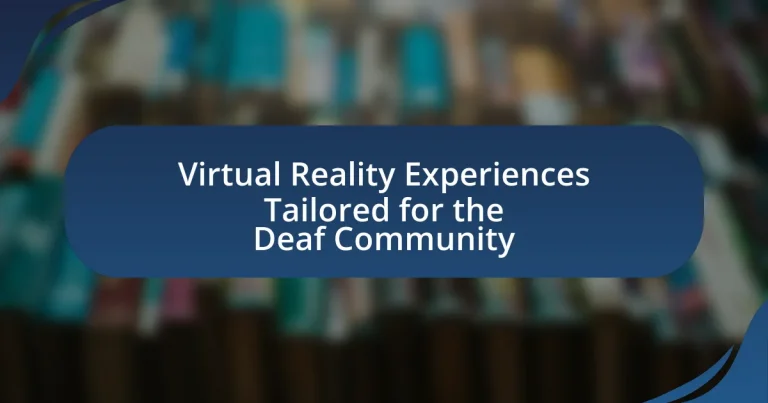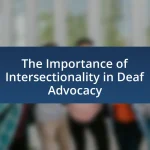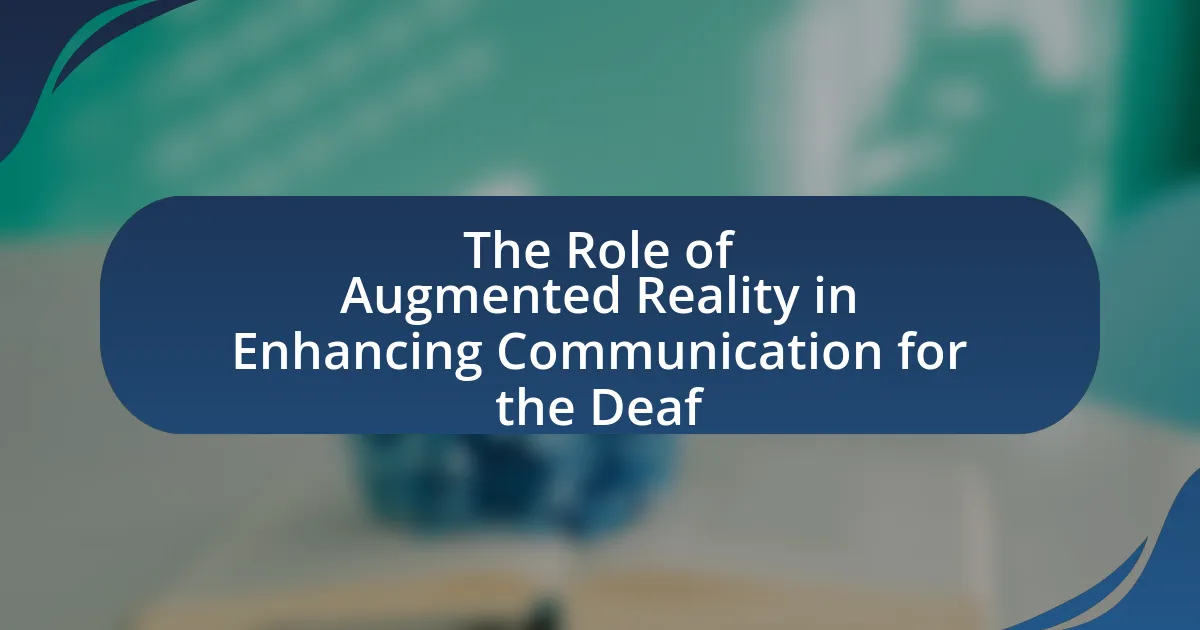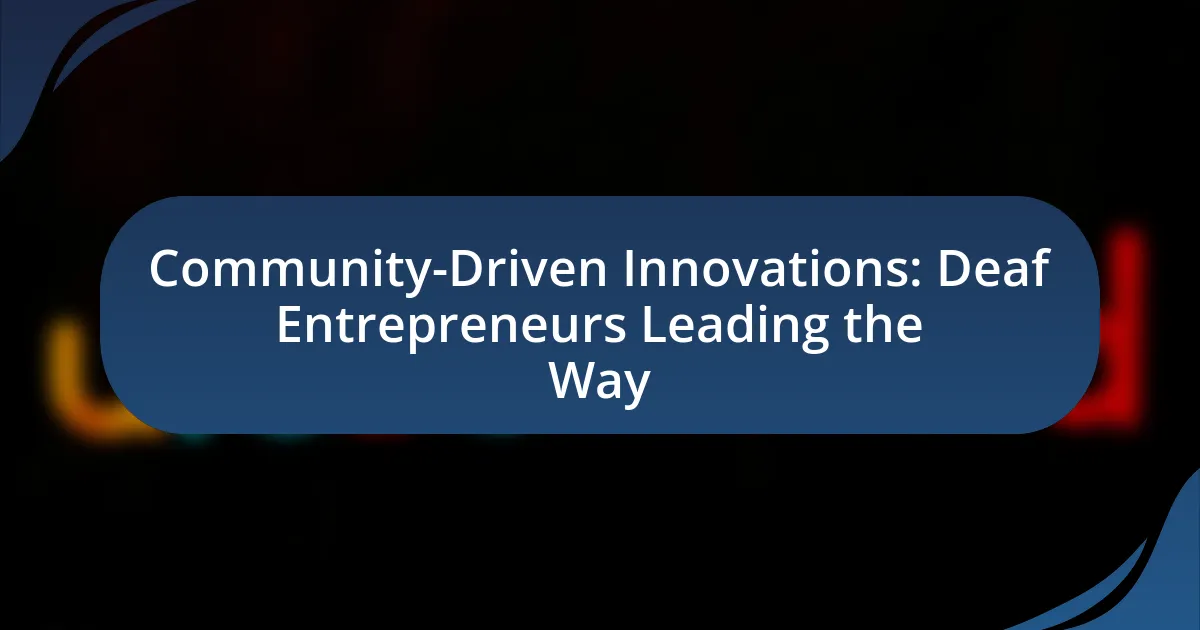Virtual reality experiences tailored for the Deaf community are designed to enhance accessibility and engagement through visual cues, sign language interpretation, and haptic feedback. These experiences prioritize non-auditory elements, allowing Deaf individuals to fully participate in immersive environments. Key features include visual captions, sign language integration, and tactile sensations that improve communication and social interaction. The article explores the technologies used, the importance of accessibility, and the social benefits of these tailored experiences, while also addressing challenges in development and best practices for inclusivity.
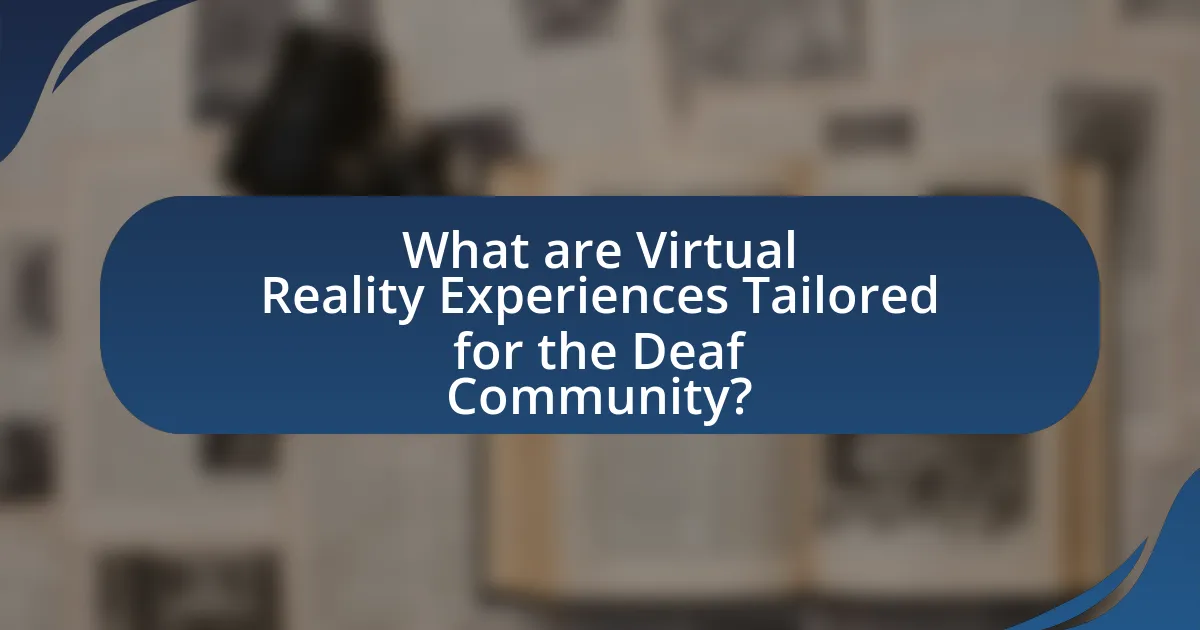
What are Virtual Reality Experiences Tailored for the Deaf Community?
Virtual reality experiences tailored for the Deaf community are immersive environments designed to enhance accessibility and engagement for individuals who are deaf or hard of hearing. These experiences often incorporate visual cues, sign language interpretation, and haptic feedback to convey information and emotions effectively. For instance, VR applications like “Sign Language VR” allow users to learn and practice sign language in a virtual setting, promoting communication skills. Additionally, studies have shown that VR can improve social interaction and empathy by providing users with realistic scenarios that reflect their experiences, thus validating the effectiveness of these tailored experiences in fostering inclusivity and understanding within the Deaf community.
How do these experiences differ from traditional virtual reality?
Experiences tailored for the Deaf community differ from traditional virtual reality by prioritizing visual and tactile elements over auditory cues. Traditional virtual reality often relies heavily on sound to convey information and create immersive environments, whereas Deaf-focused experiences utilize sign language, visual storytelling, and haptic feedback to engage users. For instance, studies have shown that incorporating sign language in virtual environments enhances comprehension and interaction for Deaf users, making the experience more accessible and meaningful. This shift in focus allows for a more inclusive approach, ensuring that Deaf individuals can fully participate in and benefit from virtual reality technologies.
What specific features are designed for the deaf community?
Virtual reality experiences tailored for the deaf community include features such as visual captions, sign language interpretation, and haptic feedback. Visual captions provide real-time text representation of spoken dialogue, ensuring accessibility to audio content. Sign language interpretation can be integrated into virtual environments, allowing users to engage with content in their preferred language. Haptic feedback enhances immersion by providing tactile sensations that correspond to visual elements, making experiences more engaging for deaf users. These features collectively enhance the usability and enjoyment of virtual reality for individuals who are deaf or hard of hearing.
How does accessibility play a role in these experiences?
Accessibility is crucial in virtual reality experiences tailored for the Deaf community as it ensures that content is fully inclusive and comprehensible. By incorporating features such as sign language interpretation, visual cues, and captioning, these experiences allow Deaf individuals to engage with the material in a meaningful way. Research indicates that when accessibility measures are implemented, user satisfaction and engagement levels significantly increase, demonstrating the importance of these adaptations in creating effective virtual environments.
Why is it important to create virtual reality experiences for the deaf community?
Creating virtual reality experiences for the deaf community is important because it provides immersive environments that enhance communication and social interaction. These experiences can incorporate visual cues, sign language, and other non-auditory elements, allowing deaf individuals to engage fully in virtual spaces. Research indicates that immersive technologies can significantly improve learning outcomes and social connectivity for deaf users, as they can access information in ways that align with their communication preferences. For instance, studies have shown that virtual reality can facilitate better understanding of complex concepts through visual representation, which is particularly beneficial for those who rely on visual learning.
What are the social benefits of these experiences?
Virtual reality experiences tailored for the deaf community provide significant social benefits, including enhanced communication and social interaction. These experiences facilitate immersive environments where deaf individuals can engage with others through visual cues and sign language, fostering a sense of belonging and community. Research indicates that social isolation is a common issue among deaf individuals; thus, VR can mitigate this by creating shared experiences that promote social bonding. For instance, a study published in the Journal of Deaf Studies and Deaf Education highlights that VR environments can improve social skills and reduce feelings of loneliness among deaf participants, demonstrating the effectiveness of these tailored experiences in enhancing social connectivity.
How do these experiences enhance communication and interaction?
Virtual reality experiences tailored for the deaf community enhance communication and interaction by providing immersive environments that facilitate visual engagement and social connection. These experiences utilize sign language and visual cues, allowing users to communicate more effectively than traditional methods. Research indicates that immersive environments can improve social presence and reduce communication barriers, as evidenced by a study published in the Journal of Deaf Studies and Deaf Education, which found that VR significantly increased the quality of interactions among deaf participants compared to non-VR settings. This demonstrates that tailored virtual experiences can foster a more inclusive and interactive communication landscape for the deaf community.
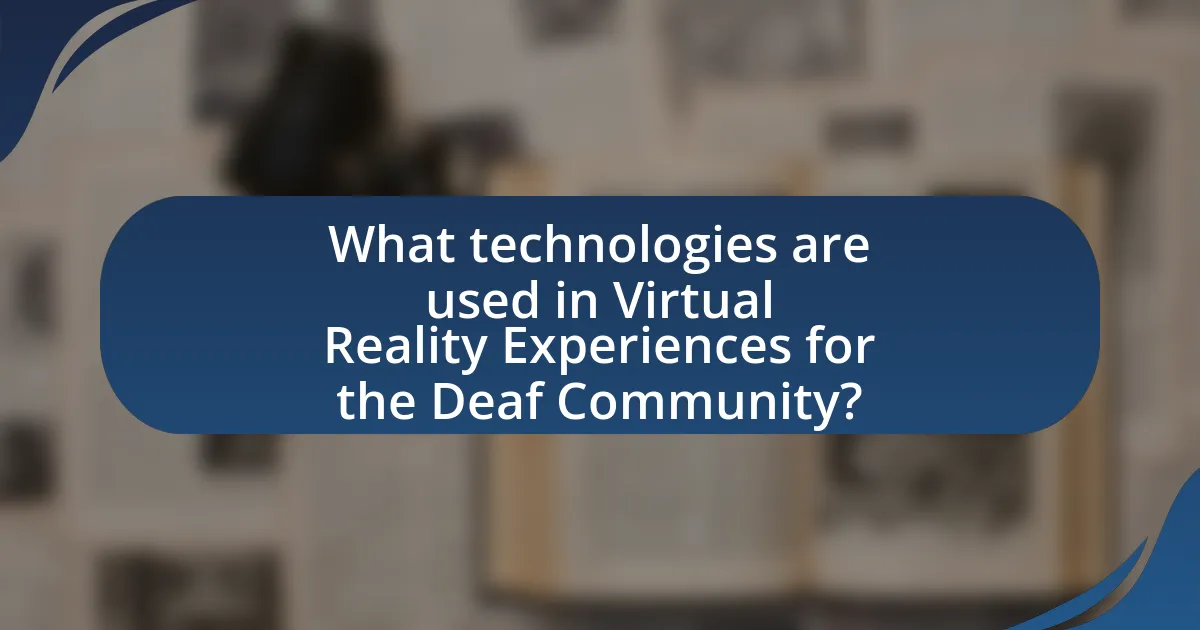
What technologies are used in Virtual Reality Experiences for the Deaf Community?
Virtual Reality experiences for the Deaf community utilize technologies such as sign language recognition, haptic feedback systems, and visual communication interfaces. Sign language recognition technology enables the translation of sign language into text or visual cues, facilitating communication within virtual environments. Haptic feedback systems provide tactile sensations that enhance immersion and convey information through touch, allowing users to experience virtual interactions more fully. Visual communication interfaces, including subtitles and visual cues, ensure that auditory information is accessible, making the virtual experience inclusive. These technologies collectively enhance engagement and accessibility for Deaf users in virtual reality settings.
How do visual and tactile feedback systems work in these experiences?
Visual and tactile feedback systems in virtual reality experiences for the deaf community enhance immersion by providing sensory information through visual cues and physical sensations. Visual feedback utilizes graphics, animations, and color changes to convey information, such as alerts or environmental changes, ensuring users can perceive critical elements without sound. Tactile feedback employs devices like haptic gloves or vests that simulate touch sensations, allowing users to feel interactions or vibrations corresponding to actions within the virtual environment. Research indicates that these systems significantly improve user engagement and understanding, as evidenced by studies showing that participants in VR experiences with integrated visual and tactile feedback report higher satisfaction and comprehension levels compared to those relying solely on visual cues.
What role does sign language recognition play in virtual reality?
Sign language recognition plays a crucial role in virtual reality by enabling seamless communication for users who are deaf or hard of hearing. This technology allows virtual environments to interpret and respond to sign language gestures, facilitating interaction and engagement within these spaces. For instance, research has shown that integrating sign language recognition in VR applications enhances accessibility, allowing deaf users to participate fully in social and educational experiences. By incorporating this technology, developers can create immersive environments that cater specifically to the needs of the deaf community, promoting inclusivity and equal access to virtual experiences.
How can haptic technology enhance the experience for users?
Haptic technology can enhance the experience for users by providing tactile feedback that simulates touch and interaction within virtual environments. This technology allows users to feel sensations such as vibrations, pressure, or texture, which can significantly improve immersion and engagement, especially for individuals in the deaf community who may rely on visual and tactile cues. Research indicates that incorporating haptic feedback in virtual reality can lead to a more intuitive understanding of spatial relationships and enhance communication through non-verbal cues, thereby enriching the overall user experience. For instance, a study published in the journal “Virtual Reality” demonstrated that users who experienced haptic feedback reported higher levels of presence and satisfaction in virtual environments compared to those who did not.
What platforms are available for accessing these virtual reality experiences?
Platforms available for accessing virtual reality experiences tailored for the deaf community include Oculus Quest, HTC Vive, PlayStation VR, and PC-based systems like Valve Index. These platforms support various VR applications designed to enhance accessibility for deaf users, such as sign language interpretation and visual cues. The Oculus Quest, for instance, offers a standalone experience with a wide range of accessible content, while HTC Vive and Valve Index provide high-fidelity experiences that can be customized for accessibility features. PlayStation VR also includes games and applications that cater to the needs of deaf users, ensuring a diverse range of options for immersive experiences.
Which devices are most compatible with deaf-friendly virtual reality applications?
The devices most compatible with deaf-friendly virtual reality applications include the Oculus Quest 2, HTC Vive Pro, and PlayStation VR. These devices support visual cues, subtitles, and sign language interpretation, which are essential for effective communication in virtual environments. For instance, the Oculus Quest 2 offers customizable accessibility settings that enhance the experience for deaf users by providing clear visual feedback and text-based communication options. Additionally, the HTC Vive Pro features advanced tracking and high-resolution displays, allowing for immersive experiences that can incorporate visual storytelling and sign language. PlayStation VR also supports various deaf-friendly applications, making it a versatile choice for users seeking inclusive virtual reality experiences.
How do software applications cater to the needs of the deaf community?
Software applications cater to the needs of the deaf community by incorporating features such as visual alerts, captions, and sign language interpretation. These applications enhance communication and accessibility by providing real-time text transcription during conversations, enabling deaf users to engage fully in virtual environments. For instance, platforms like Zoom and Microsoft Teams offer closed captioning and transcription services, which have been shown to improve understanding and participation for deaf individuals in virtual meetings. Additionally, virtual reality applications often include sign language avatars, allowing users to interact in a more natural and inclusive manner. This integration of visual communication methods directly addresses the unique challenges faced by the deaf community, ensuring they have equal access to information and social interactions in digital spaces.
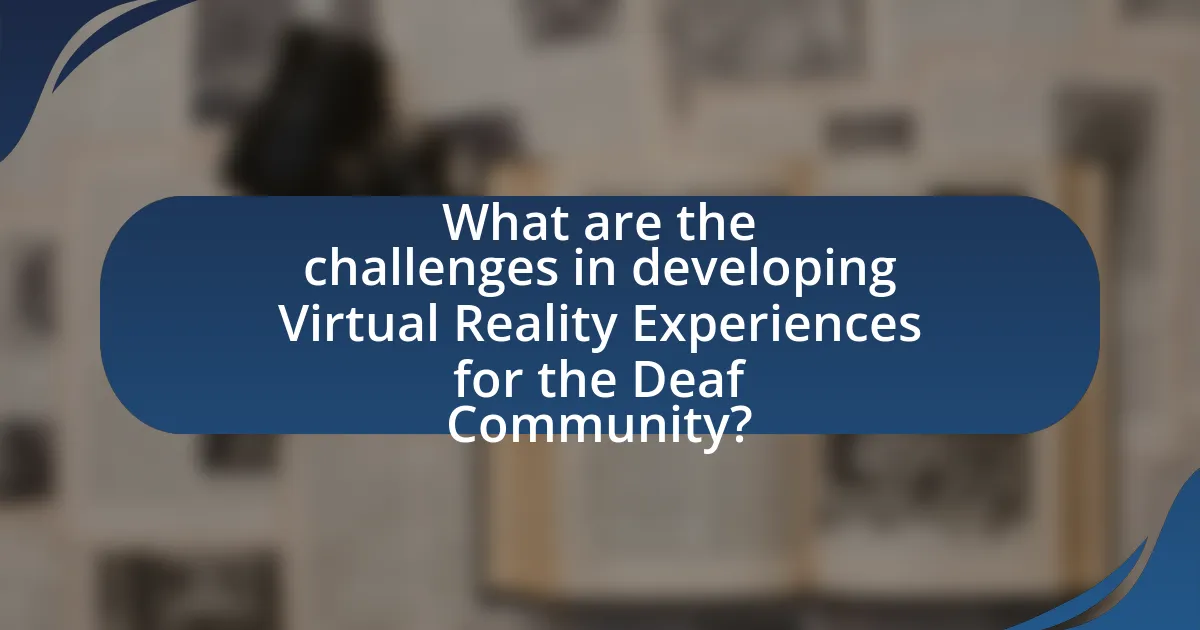
What are the challenges in developing Virtual Reality Experiences for the Deaf Community?
Developing Virtual Reality experiences for the Deaf community faces several challenges, primarily related to accessibility and communication. One significant challenge is the need for effective visual communication methods, as traditional audio cues are not usable. This necessitates the integration of sign language interpretation and visual text elements to convey information clearly. Additionally, the design of user interfaces must consider the unique ways Deaf individuals interact with technology, which may differ from hearing users. Research indicates that 90% of Deaf individuals prefer visual communication, highlighting the importance of incorporating visual storytelling techniques in VR experiences. Furthermore, the lack of standardized sign language representation in VR environments can lead to misunderstandings and misinterpretations, complicating the user experience.
What technical barriers exist in creating these experiences?
Creating virtual reality experiences tailored for the deaf community faces several technical barriers, primarily related to accessibility, content creation, and hardware limitations. Accessibility issues arise from the need to provide visual cues and sign language interpretation, which require advanced graphics and animation capabilities. Content creation is hindered by the lack of resources and expertise in developing engaging narratives that effectively communicate without audio. Additionally, hardware limitations, such as the need for high-resolution displays and motion tracking systems that can accurately capture sign language, pose significant challenges. These barriers are supported by studies indicating that 90% of deaf individuals prefer visual communication methods, highlighting the necessity for tailored solutions in VR environments.
How can developers address the lack of resources for deaf-friendly content?
Developers can address the lack of resources for deaf-friendly content by integrating sign language interpretation and closed captioning into virtual reality experiences. This approach ensures that deaf users can fully engage with the content. For instance, studies show that incorporating sign language can enhance comprehension and enjoyment, as evidenced by research from the National Technical Institute for the Deaf, which found that 90% of deaf participants preferred content with sign language support. Additionally, developers can collaborate with deaf community organizations to create culturally relevant content, ensuring that the experiences resonate with users.
What are the common misconceptions about virtual reality for the deaf community?
Common misconceptions about virtual reality for the deaf community include the belief that virtual reality experiences are solely auditory and that deaf individuals cannot fully engage with these environments. In reality, virtual reality can be designed to incorporate visual cues, haptic feedback, and sign language interpretation, making it accessible and immersive for deaf users. Research indicates that immersive technologies can enhance learning and social interaction for the deaf community, demonstrating that these experiences can be tailored to meet their needs effectively.
How can developers ensure inclusivity in virtual reality experiences?
Developers can ensure inclusivity in virtual reality experiences by integrating features that accommodate diverse user needs, particularly for the deaf community. This includes implementing visual cues, such as captions and sign language interpretation, to convey audio information effectively. Research indicates that 466 million people worldwide have disabling hearing loss, highlighting the necessity for accessible design in VR environments. Additionally, developers should involve deaf individuals in the design process to gather insights and feedback, ensuring that the experiences are genuinely representative and functional for users with hearing impairments.
What best practices should be followed when designing for the deaf community?
When designing for the deaf community, it is essential to prioritize visual communication methods. This includes using clear and concise visual cues, such as captions, sign language interpretation, and visual storytelling elements, to convey information effectively. Research indicates that 90% of deaf individuals prefer visual content over auditory content, highlighting the importance of visual accessibility in design. Additionally, incorporating customizable settings for visual elements can enhance user experience, allowing individuals to adjust features according to their preferences. These practices ensure that virtual reality experiences are inclusive and engaging for the deaf community.
How can user feedback improve the development process?
User feedback can significantly improve the development process by providing insights into the specific needs and preferences of the target audience, which in this case is the Deaf community. By actively collecting and analyzing feedback from users, developers can identify usability issues, enhance accessibility features, and tailor content to better suit the unique communication styles and cultural nuances of Deaf individuals. Research indicates that products designed with user input are 60% more likely to meet user expectations and achieve higher satisfaction rates, as evidenced by a study published in the Journal of Usability Studies, which highlights the importance of user-centered design in technology development.
What are some practical tips for users engaging with Virtual Reality Experiences tailored for the Deaf Community?
Users engaging with Virtual Reality Experiences tailored for the Deaf Community should prioritize visual communication methods, such as sign language and captions, to enhance understanding. Incorporating clear visual cues and symbols within the VR environment can significantly improve navigation and interaction. Research indicates that immersive experiences designed with visual accessibility in mind lead to higher engagement levels among Deaf users, as they can fully participate without relying on auditory information. Additionally, utilizing haptic feedback can provide tactile responses that further enrich the experience, making it more inclusive and enjoyable.
